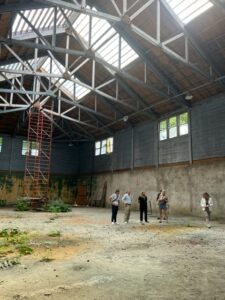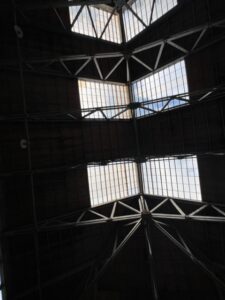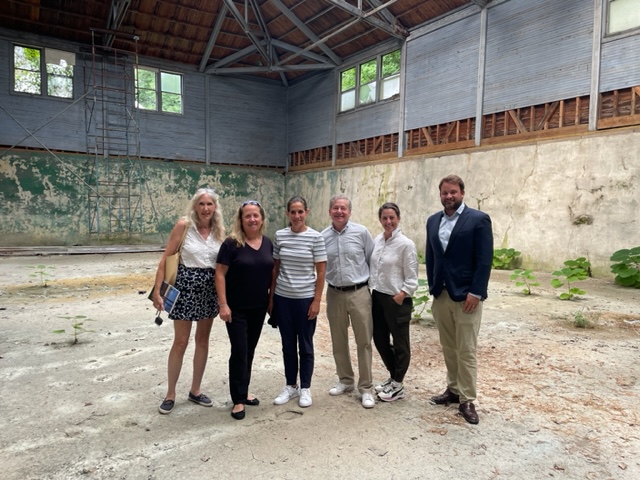 Immediately following the US Open and electrifying wins by Coco Gauff and Novak Djokovic, USTA Executive Director & CEO Jennifer Schnitzer and Susan Friedlaender, the Senior Manager of Adult Leagues took the time to visit the historic 1916 Indoor Palmer Tennis House at the Jay Estate. JHC President Suzanne Clary, JHC Tennis Committee Co-Chairs, Lindsay Martin and Nicholas Cassin together with JHC Office Manager Meredith Slater, NY State Assemblyman Steve Otis and his Chief of Staff Lisa Urban led the tour.
Immediately following the US Open and electrifying wins by Coco Gauff and Novak Djokovic, USTA Executive Director & CEO Jennifer Schnitzer and Susan Friedlaender, the Senior Manager of Adult Leagues took the time to visit the historic 1916 Indoor Palmer Tennis House at the Jay Estate. JHC President Suzanne Clary, JHC Tennis Committee Co-Chairs, Lindsay Martin and Nicholas Cassin together with JHC Office Manager Meredith Slater, NY State Assemblyman Steve Otis and his Chief of Staff Lisa Urban led the tour.
In 2015, USTA helped JHC apply for a $391,056 grant from NY State Parks to save the building. Prior to that, years of inattention compounded by Hurricane Sandy damage posed a threat of catastrophic failure to the roof, sill and supporting beams of the historic building. There were no existing photos or plans of the sporting facility so JHC hired award-winning Stephen Tilly Architects and Silman Engineers to create some. They then hired Apple Waterproofing of NYC and successfully completed a first phase of stabilization by 2020. This was the USTA’s first glimpse of the new restoration work.
The group discussed what still needs to be done and financed to make the court playable. The surface was originally clay and the skylights were copper. Can sustainable features or a viewing gallery be introduced? What is the capacity for events or can it be a multi-purpose space? They also talked about potential capital and grants that would fit our shared missions of serving under resourced youth. The mission of the USTA Foundation is “to bring tennis and education together to change lives.” In the Westchester area – particularly Port Chester, Mamaroneck, Mount Vernon, Yonkers, Greenburgh and White Plains – JHC has longstanding relationships with schools and nonprofits who would benefit greatly from access to a tennis facility on our campus paired with some of the educational resources and curricula we can offer.
Believe it or not, the Palmer Tennis House continued in use until the 1990s before falling into disrepair. JHC welcomes photos or recollections from the public if anyone has them. Please email Suzanne Clary. JHC is also working with the historians at the International Tennis Hall of Fame to discover more about the history of the building and put it in the context of the evolution of the sport. For example, the building was constructed in 1916, a momentous year for tennis – the same year that the American Tennis Association (ATA) was founded with the aim of “promoting the sport among African-Americans, encouraging the formation of more local clubs and associations, and developing more junior players.” People interested in working with the JHC Tennis Committee can contact Meredith Slater.
* * * *
HISTORIC SIGNIFICANCE

Based on maps and historic surveys, the Palmer Tennis House at the Jay Estate is likely to be the 8th oldest indoor tennis court in the United States but all the others are privately owned so its preservation and rehabilitation for public use creates a rare opportunity.
Its architect is unknown but its design is similar to 2 other enclosed tennis facilities created by New York architect Walter D. Blair for the renowned Jekyll Island Club in Georgia – one in 1913 for Edwin Gould, son of financier Jay Gould and one in 1929 for J.P. Morgan.
Princeton benefactor Edgar Palmer (Class of ’03) purchased the Jay Estate in Rye in 1911 and commissioned a survey of the property in 1917 by Brinley & Holbrook which identified an existing tennis house on the southwest corner of the property near Barlow Lane. Covered or “enclosed” tennis courts for individuals or even for private or athletic clubs were virtually unheard of at this time because of the expense involved in erecting them. Palmer and his father were members of the Jekyll Island Club as of 1913 when the first indoor court was erected and would have certainly been familiar with the building and possibly its architect W. D. Blair. Palmer also had social and business dealings with the Gould and Morgan families as a member of American Yacht Club in Rye (founded by Jay Gould) and New York Yacht Club (of which JP Morgan was a prominent member.)
The building and surrounding grounds were passed down to Edgar Palmer’s daughter and husband, Zilph and Walter Devereux who opened the facility regularly to national caliber high school tennis players for the Eastern Interscholastic Doubles Championships in the 1950s and 60s. JHC has thus far traced the career of at least one of the students who won a tournament there, Sean Sloane (Princeton Class of ’64). Sloane went on to pursue a much-lauded career in coaching at Williams College, followed by work with the USTA; a coveted sportsmanship award is named in his honor.
